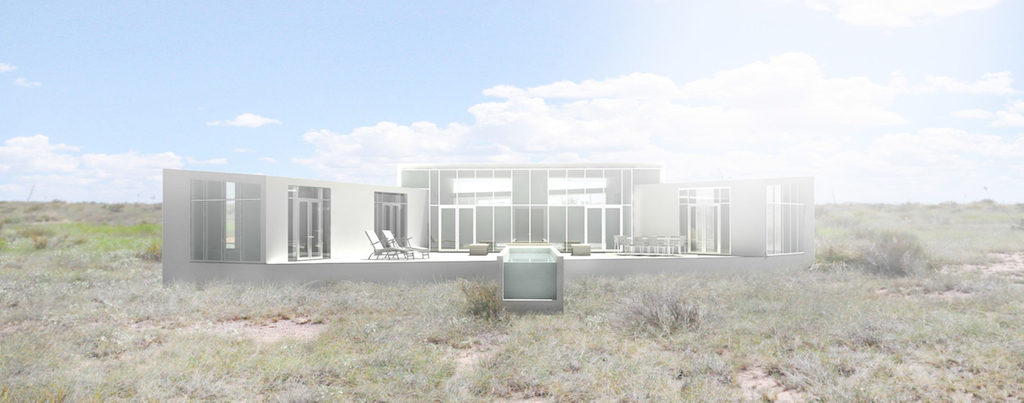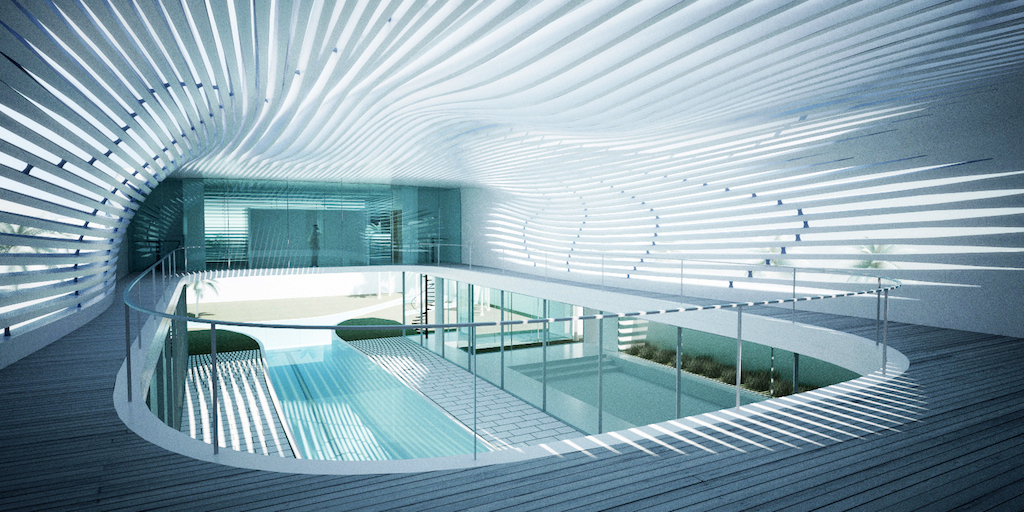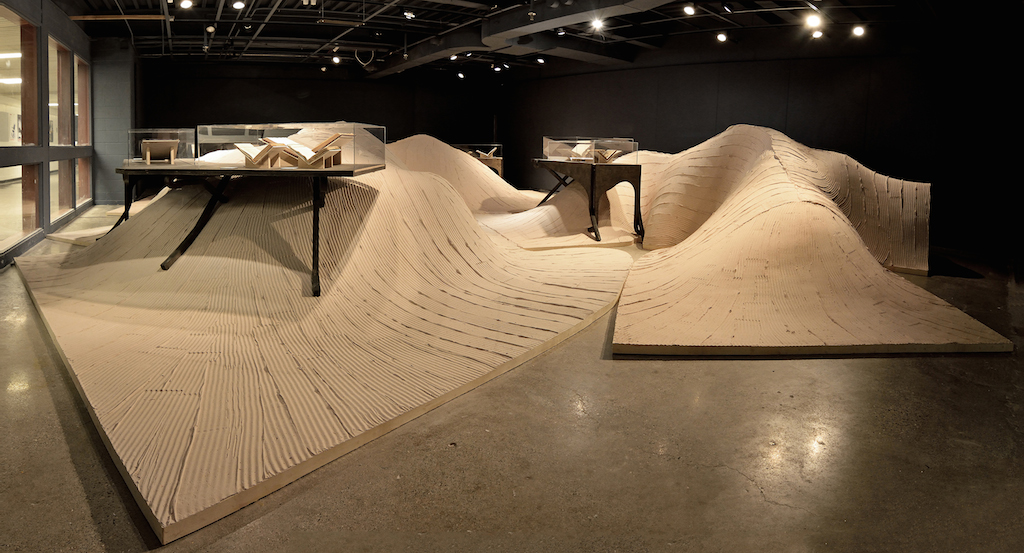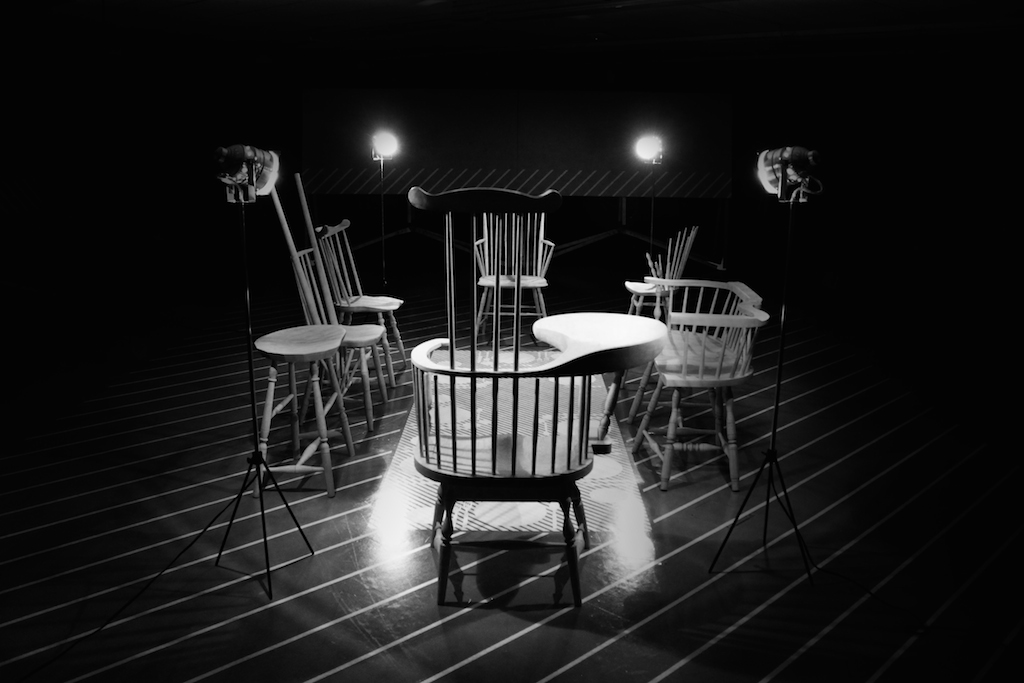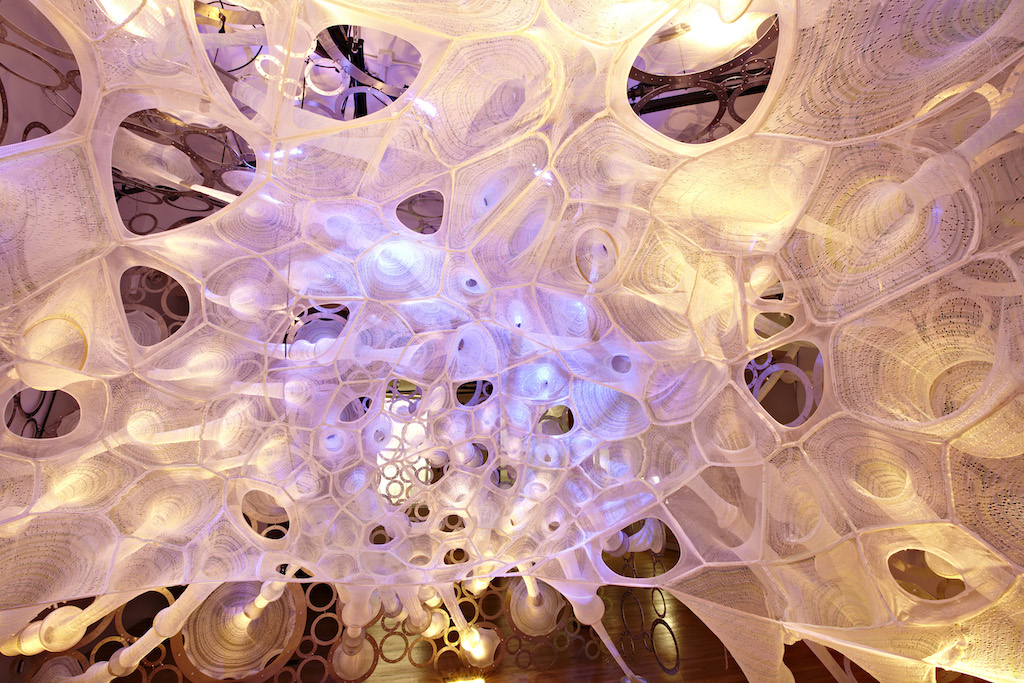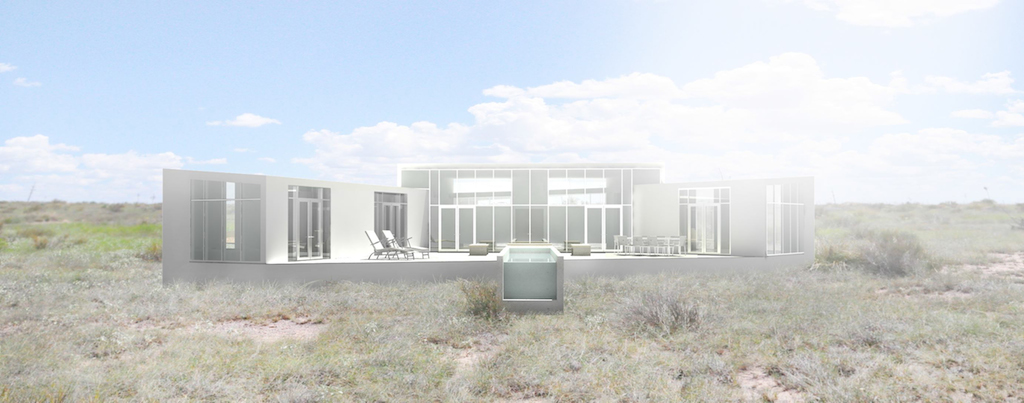The Architectural League Prize, created in 1981, "recognizes exemplary and provocative work by young practitioners and provides a public forum for the exchange of their ideas."
This year, six winners were selected, from firms East Coast to West. Each will present their work in lectures, at an exhibition, and in a catalogue published by Princeton Architectural Press.
Each year, the competition has a unique theme chosen by the League's Young Architects + Designers Committee. This year, the theme was "Overlay," defined as “directs—rather than merely reconstructs—process.”
As explained in the call for entries: “We are interested in how overlay (iterative, conceptual, and notational) drives discourse, tension between iterations, design solutions, and the parameters by which work is reviewed. Overlay is unique to the designer; the techniques developed are activated overtime with layered meanings to push architectural concepts. Thus submissions might include interpretations of overlay that vary from process to presentation to product to shape and establish your identity as a young practice.”
In addition to the committee members, the 2014 Architectural League Prize jury consisted of Preston Scott Cohen, Evan Douglis, Florian Idenburg, Jennifer Lee, Charles Renfro, and Annabelle Selldorf.
Check out the winners below, with firm descriptions from the Architectural League:
Young & Ayata
Kutan Ayata and Michael Young
Brooklyn, N.Y.
In 2008, Kutan Ayata and Michael Young co-founded Young & Ayata in order to “explore novel formal and organizational possibilities in architecture and urbanism.” The Brooklyn-based partnership is committed to experimentation, and views “the reality of contemporary building as a provocation to the progression of experiments in form, material, and technology.”
The firm’s work consists of both commissions and experimental research, as they seek to engage “with contemporary cultural issues that influence and are influenced by our environment.” Recent projects include the competition scheme of an opera house in Busan, South Korea, and a conceptual master plan for the Aalto University Campus Center in Helsinki, Finland.
Kutan Ayata received a Bachelor of Fine Arts in Architecture from the Massachusetts College of Art in Boston and a Masters in Architecture from Princeton University, where he was a recipient of the Suzanne Kolarik Underwood Thesis Prize. He is an Adjunct Assistant Professor at Pratt Institute’s GAUD and a Lecturer at University of Pennsylvania.
Michael Young received a Bachelor of Architecture from Cal Poly San Luis Obispo and a Masters of Architecture from Princeton University, where he was also the recipient of the Suzanne Kolarik Underwood Thesis Prize and the Howard Crosby Butler Traveling Fellowship in Architecture. He is an Assistant Professor at The Irwin S. Chanin School of Architecture at The Cooper Union and teaches in the core graduate design studio at the Yale University School of Architecture.
Kutan Ayata and Michael Young will discuss their work on June 26, 2014, in a public lecture.
The LADG
Claus Benjamin Freyinger and Andrew Holder
Los Angeles
Established in 2004, The Los Angeles Design Group (The LADG), is led by principals Claus Benjamin Freyinger and Andrew Holder. The firm works at all scales, and has completed projects in California, Colorado, Hawaii, Minnesota, New York, Oregon, and the United Kingdom.
The founders see their work as contributing to a “longer history of ideas,” and draw on this history to craft unexpected solutions to conventional problems. Recent projects include installations at the Taubman College Gallery at the University of Michigan, and several commercial interior renovations in New York and Santa Monica.
Claus Benjamin Freyinger received a Bachelor of Arts in Art History from Boston College and his Master of Architecture from the University of California Los Angeles in 2005. Andrew Holder received a Bachelor of Arts in Political Science from Lewis and Clark College and his Master of Architecture from the University of California Los Angeles in 2005. He is an Assistant Professor at the University of Michigan, where he was the 2012-2013 Oberdick Fellow.
Claus Benjamin Freyinger and Andrew Holder will discuss their work on June 24, 2014 in a public lecture.
SIFT Studio
Adam Fure
Ann Arbor, Mich.
Adam Fure and his Ann Arbor design practice, SIFT Studio, enliven, in his words, “old substances through new treatments; composing new aesthetic mixtures from the matter at [one’s] fingertips.” Through these experiments, SIFT Studio “promotes architecture’s unique capacity to shape experience, which is neither essentialized nor thought to be static and singular.”
Recent work includes a multimedia installation in Stuttgart, Germany, that transforms space, sound, and light into variable dimensions, and a conceptual mirror house that was a finalist for BOFFO Building Fashion’s Linda Farrow competition in 2013.
Adam Fure received a Bachelor of Science in Architecture from Taubman College of Architecture and Urban Planning at the University of Michigan and a Masters of Architecture with Distinction from the Department of Architecture and Urban Design at the University of California Los Angeles in 2006. He is an Assistant Professor at the Taubman College of Architecture and Urban Planning at the University of Michigan.
Adam Fure will discuss his work on June 24, 2014 in a public lecture.
Norman Kelley
Thomas Kelley and Carrie Norman
Brooklyn, N.Y. and Chicago
Thomas Kelley and Carrie Norman founded the Brooklyn- and Chicago-based design collaborative Norman Kelley in 2012. Through their work Kelley and Norman seek to “vulgarize, satirize, and reposition (lofty) material to elevate the ordinary.”
Recent projects include Wrong Chairs, in which they “purposefully disrupt the notion of ‘correctness’” with stylized abstractions of the iconic Windsor Chair, and Shape Shape Evolution, an interior playhouse for the Early Learning Play Foundation in Chicago. Norman Kelley’s drawings for Ignacio Gonzalez will be exhibited at the 2014 Venice Architecture Biennale.
Kelley received a Bachelor of Science in Architecture with Honors from the University of Virginia and a Master in Architecture from Princeton University. He is currently a Visiting Assistant Professor at the University of Illinois at Chicago and the James R. Lamantia, Jr. Rome Prize Fellow at the American Academy in Rome. Norman also received a Bachelor of Science in Architecture with Honors from the University of Virginia and a Master in Architecture from Princeton University. She is presently a design associate with SHoP Architects.
Thomas Kelley and Carrie Norman will discuss their work on June 26, 2014 in a public lecture.
Jenny Sabin Studio
Jenny E. Sabin, Principal and Founder of Philadelphia-based Jenny Sabin Studio, is an architectural designer, artist, and educator. Her work, in her own words, “investigates the intersection of architecture and science, and applies insights and theories from biology and mathematics to the design of material structures.”
Past projects include Branching Morphogenesis, a three-dimensional “datascape” made up of 75,000 zip ties; Polymorph, a project exploring digital fabrication of ceramic form; and myThread Pavilion, a work commissioned by Nike Flyknit Collective. Last year Jenny Sabin Studio, in collaboration with ISA Architects, worked on a new 31-unit housing development in Francisville, Philadelphia.
Sabin is currently an Assistant Professor at Cornell University. She is also the founder and director of Sabin Design Lab at Cornell and the co-founder of the research and design network LabStudio. Sabin holds an undergraduate degree with Honors in Ceramics and Interdisciplinary Visual Art from the University of Washington and a Master of Architecture from the University of Pennsylvania.
Jenny Sabin will discuss her work on June 26, 2014 in a public lecture.
Geoffrey von Oeyen Design
Geoffrey von Oeyen
Los Angeles
Geoffrey von Oeyen is Founder and Principal of Los Angeles-based Geoffrey von Oeyen Design. His work, as he describes it, “mediate[s] between the existing and the new with the aim of reframing and redirecting existing views, patterns, and orientations.” Von Oeyen characterizes the relationship within each project as: “a dialogue that seeks to reveal essential geometric paradigms.”
The practice has several projects in development across California, Texas, Georgia, and Puerto Rico. Two located in Malibu, California, the Horizon House and the Case Room, a private study for two attorneys, are due to begin construction this summer.
Von Oeyen received a Bachelor of Arts with Honors in Urban Studies and minors in Art History and History from Stanford University. He was a US/UK Fulbright Scholar at the University of Cambridge, where he obtained a Master of Philosophy in History and Philosophy of Architecture. Von Oeyen received a Master of Architecture from the Harvard Graduate School of Design, where he was awarded the Faculty Design Award. He is currently a faculty member at the USC School of Architecture.
Geoffrey von Oeyen will discuss his work on June 24, 2014 in a public lecture.
Related Stories
| Aug 11, 2010
Florida mixed-use complex includes retail, residential
The $325 million Atlantic Plaza II lifestyle center will be built on 8.5 acres in Delray Beach, Fla. Designed by Vander Ploeg & Associates, Boca Raton, the complex will include six buildings ranging from three to five stories and have 182,000 sf of restaurant and retail space. An additional 106,000 sf of Class A office space and a residential component including 197 apartments, townhouses, ...
| Aug 11, 2010
Restoration gives new life to New Formalism icon
The $30 million upgrade, restoration, and expansion of the Mark Taper Forum in Los Angeles was completed by the team of Rios Clementi Hale Studios (architect), Harley Ellis Devereaux (executive architect/MEP), KPFF (structural engineer), and Taisei Construction (GC). Work on the Welton Becket-designed 1967 complex included an overhaul of the auditorium, lighting, and acoustics.
| Aug 11, 2010
Best AEC Firms to Work For
2006 FreemanWhite Hnedak Bobo Group McCarthy Building Companies, Inc. Shawmut Design and Construction Walter P Moore 2007 Anshen+Allen Arup Bovis Lend Lease Cannon Design Jones Lang LaSalle Perkins+Will SmithGroup SSOE, Inc. Timothy Haahs & Associates, Inc. 2008 Gilbane Building Co. HDR KJWW Engineering Consultants Lord, Aeck & Sargent Mark G.
| Aug 11, 2010
High-Performance Workplaces
Building Teams around the world are finding that the workplace is changing radically, leading owners and tenants to reinvent corporate office buildings to compete more effectively on a global scale. The good news is that this means more renovation and reconstruction work at a time when new construction has stalled to a dribble.
| Aug 11, 2010
Great Solutions: Business Management
22. Commercial Properties Repositioned for University USE Tocci Building Companies is finding success in repositioning commercial properties for university use, and it expects the trend to continue. The firm's Capital Cove project in Providence, R.I., for instance, was originally designed by Elkus Manfredi (with design continued by HDS Architects) to be a mixed-use complex with private, market-...
| Aug 11, 2010
Nurturing the Community
The best seat in the house at the new Seahawks Stadium in Seattle isn't on the 50-yard line. It's in the southeast corner, at the very top of the upper bowl. "From there you have a corner-to-corner view of the field and an inspiring grasp of the surrounding city," says Kelly Kerns, project leader with architect/engineer Ellerbe Becket, Kansas City, Mo.
| Aug 11, 2010
AIA Course: Historic Masonry — Restoration and Renovation
Historic restoration and preservation efforts are accelerating throughout the U.S., thanks in part to available tax credits, awards programs, and green building trends. While these projects entail many different building components and systems, façade restoration—as the public face of these older structures—is a key focus. Earn 1.0 AIA learning unit by taking this free course from Building Design+Construction.
| Aug 11, 2010
BIM adoption tops 80% among the nation's largest AEC firms, according to BD+C's Giants 300 survey
The nation's largest architecture, engineering, and construction companies are on the BIM bandwagon in a big way, according to Building Design+Construction's premier Top 50 BIM Adopters ranking, published as part of the 2009 Giants 300 survey. Of the 320 AEC firms that participated in Giants survey, 83% report having at least one BIM seat license in house, half have more than 30 seats, and near...
| Aug 11, 2010
World's tallest all-wood residential structure opens in London
At nine stories, the Stadthaus apartment complex in East London is the world’s tallest residential structure constructed entirely in timber and one of the tallest all-wood buildings on the planet. The tower’s structural system consists of cross-laminated timber (CLT) panels pieced together to form load-bearing walls and floors. Even the elevator and stair shafts are constructed of prefabricated CLT.
| Aug 11, 2010
Integrated Project Delivery builds a brave, new BIM world
Three-dimensional information, such as that provided by building information modeling, allows all members of the Building Team to visualize the many components of a project and how they work together. BIM and other 3D tools convey the idea and intent of the designer to the entire Building Team and lay the groundwork for integrated project delivery.


